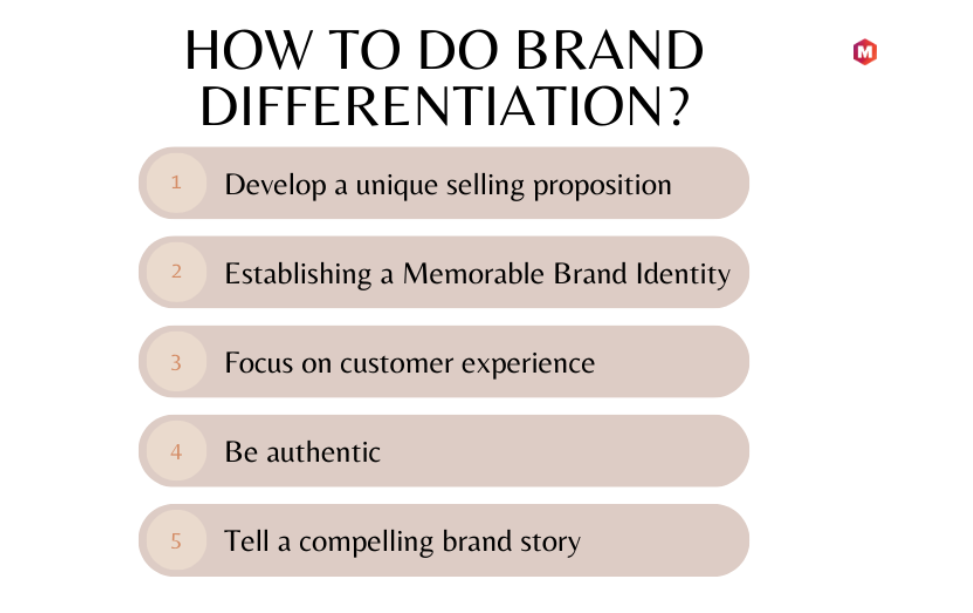Table of Contents
What is Brand Differentiation?
Brand differentiation creates a brand identity that sets the brand apart from competitors. Brand differentiation helps brands charge premium prices and build brand loyalty.
Some common ways to differentiate a brand include using physical characteristics like the packaging to create a unique look, advertising and marketing to create positive brand perceptions among consumers, and creating a brand identity based on a unique selling proposition.
Brand distinctiveness distinguishes a product or firm from its competitors. Branding is a powerful marketing tool, and a well-differentiated brand can give a business a competitive edge.
Popular ways to differentiate are creating a unique selling proposition, a strong brand identity, and focusing on customer experience. Brand differentiation is about going beyond being different to make a difference that matters to your target market and resonates with your customers.
You must understand your target market and their needs to differentiate your brand. Knowing what customers want lets you establish a brand that stands out. Creating a solid brand identity that reflects your company’s beliefs and personality is crucial to brand uniqueness and customer emotional connection.
Key Takeaways:
- Brand differentiation enhances identity and allows for premium pricing and consumer loyalty.
- Common differentiation strategies include unique packaging, targeted advertising, and a distinct selling proposition.
- A well-differentiated brand provides a competitive edge through a strong identity and customer experience.
- Understanding target market needs is crucial for establishing a standout brand that connects emotionally with customers.
Why is Brand Differentiation Important?
Some of the reasons why differentiation is essential are
1. It can help you stand out in a crowded marketplace
Today’s competitive business environment makes it crucial to differentiate your organization. One of the best methods for this is brand building and differentiation.
2. It can help you build a solid and memorable brand
Potential customers remember differentiated brands more than generic ones. Brand uniqueness may help you build a strong, memorable brand identity that keeps your target market thinking of your firm.
3. It can help you improve customer satisfaction
Any business needs customer happiness, but it is hard to get if you are not unique. Brand uniqueness may create a memorable customer experience that keeps them coming back.
4. It can help you attract and retain the best employees
Companies with distinct brands attract top talent. Brand uniqueness may make your organization an employer of choice, attracting and retaining top personnel.
5. It can help you command a higher price
Brand differences might also justify high prices. Customers will pay more for your products and services if they think your firm is distinctive and valuable.
How to Evaluate Your Brand to Achieve Strong Brand Differentiation
Understanding your brand’s structure is essential to brand uniqueness. Brand identity includes vision, mission, product hierarchy, value proposition, organizational culture, and more, not only its name or logo. Consider the whole experience and the feelings you generate in customers as they shape their brand perception.
Identify your brand’s value proposition for true differentiation. Consider a brand audit or revitalization if your brand lacks a solid value proposition to reinforce or replicate its unique benefits. Align brand and business strategies. To achieve balance, they should relate to your products, services, and business goals.
Your plans should focus on your ideal customers’ wants. Your target audience’s loyalty and advocacy rise when your services match their needs, leading to word-of-mouth referrals and business growth. Use a structured framework, such as Persona Brand Strategy Leadership™, to create a strong brand profile that aligns with your vision, mission, and value proposition.
Types of Brand Differentiation
Businesses must differentiate themselves in a competitive market. Brand distinctiveness can be accomplished through unique products, services, or distribution channels. We will examine three main brand differentiation methods:
- Product Differentiation
- Services Differentiation
- Differentiating Channels
Product Differentiation
Product differentiation allows companies to stand out by producing distinctive, new products that meet customers’ needs. This strategy may involve developing cutting-edge technologies, improving product design, or outperforming the Competition.
Example: Tesla’s high-quality electric vehicles with revolutionary technology, elegant style, and eco-friendliness differentiate its products. Their strategy has earned them a loyal customer base and led the electric vehicle market.
Creating distinctive products and meeting customer preferences can help a firm succeed in a changing industry.
Service Differentiation
Businesses must differentiate their offerings in today’s competitive industry. Companies may stand out and establish loyalty by prioritizing an outstanding customer service experience. Provide excellent customer service, reduce delivery times, or personalize the buying experience.
Example: Amazon’s rapid shipping, wide product range, and tailored customer experience are great examples of service distinction. Due to its exceptional customer service and customer-centric approach, Amazon is a frontrunner in online purchasing.
Differentiating services from competitors can give you an edge and build client loyalty.
Channel Differentiation
Companies may separate from the Competition by delivering special products and services through unique distribution channels. Channel differentiation enhances the purchasing experience and adds value.
Example: The beauty brand Glossier sells primarily online, creating a niche. This direct-to-consumer model lets the organization offer lower prices and learn from customers, improving the customer experience. Innovative distribution tactics might help you gain market share and new clients.
How to do Brand Differentiation?
There are many different ways to create a differentiated brand, but some common strategies include
1. Develop a unique selling proposition
A unique selling proposition (USP) outlines what sets your organization or product apart. The USP should be brief and relevant to your target market.
2. Create a solid and memorable brand identity
Brand identity is how your brand looks and feels. It should convey your brand’s values. It should reflect your company’s ideals and personality across all touchpoints.
3. Focus on customer experience
Understanding and exceeding consumers’ demands is critical to a differentiated customer experience. You can achieve this by creating a positive and memorable experience at every consumer touchpoint.
4. Be authentic
In today’s transparent environment, buyers spot fake brands immediately. You must be authentic in all you do to differentiate your brand. Avoid being anything other than your company’s principles and mission.
5. Tell a compelling brand story
Stories have the power to attach customers to your brand emotionally. Explain what makes your brand unique. Make brand experiences consistent and captivating by telling stories across all touchpoints.
33 Ways to Achieve Brand Differentiation
1. Your brand is your story. Tell it well, and people will listen
Branding is all about telling the story of your business in a way that connects with the people you want to buy from you. Tell people about your business and what makes it unique. Tell stories at all contact points with your company to make the experience consistent and exciting.
2. Be mindful of the prices you set
You can also use brand differences to avoid charging more for your goods or services. Customers will more likely pay more for your goods or services if they think your business is unique and offers better value.
3. Come up with new ideas by doing innovation
To build a unique business, you must keep developing new ideas. Always look for new ways to make your business stand out. Another good way to set your brand apart is to present yourself as a high-end one.
4. Stand Out from the Competition with a Memorable Point-of-Purchase Experience
To give your people a unique experience, you need to know what they want and need and then go above and beyond what they expect. You should see a chance to make the experience excellent and memorable at every point in the customer’s path.
5. Finding a Profitable Niche
Focusing on a small group of people is one of the best ways to make your brand stand out. You can better meet the needs and wants of a particular group of customers and build a more loyal customer base by focusing on that group.
6. Become an Expert
Becoming an expert in your field is another way to make your brand stand out. You should present yourself as an expert to get more customers and build trust with your target group.
7. Unique and Eye-catching Business Materials
Ensure your website, business cards, and other marketing tools have the same logo and color scheme. Use unique patterns and high-quality images to make your materials stand out.
8. Tackle a problem that’s common to many
Find a way to make your brand stand out by solving a problem many people have. Building a strong bond with your target audience will be easy if you can solve their problem.
9. Having a mascot is an excellent way
Creating a mascot representing your company is a fun way to differentiate your brand. This can help humanize your brand and make it more relatable to your target audience.
10. The history and origins of an item
People are often interested in the history and origins of products they purchase. Share the story of your brand and how it came to be. This can help customers feel more connected to your company.
11. Make it easy for your customers by offering convenient payment options
Differentiate your brand by making it easy for customers to do business with you. Offer convenient payment options and make the purchase process as seamless as possible.
12. Discover how to make your products stand out on store shelves and online
Because the market is so competitive now, ensuring your goods stand out is more important than ever. Make your goods stand out in stores and online by creating creative ways to package and brand them.
13. Offer a freebie with purchase
Give something away for free with every purchase to make the premium price of the deal more appealing to customers and set your brand apart from others on the market. This could be an actual item or a digital download.
14. You can more easily persuade someone if you appeal to their emotions
Use emotion to your advantage when trying to persuade someone. Find a way to connect with your audience emotionally, and you will be more successful in getting them to see your point of view.
15. Give your customers a reason to come back
Offer reasons for customers to come back to build customer loyalty and trust. This could come as a discount program, special deals, or a reward program. Take on a problem that affects many people to get to know your audience better. For example, a company selling stationery might promise to plant a tree for every paper bought. A strong connection with the brand can come from customers who like and trust the brand.
16. Use social media to your advantage
Social media is a powerful tool to help you reach a wider audience and build relationships with potential and current customers. Use social media to your advantage by posting engaging content, responding to customer inquiries, and running promotions.
17. Get involved in your Community
One way to differentiate your brand is to get involved in your Community. This can help youCommunitylationships with potential customers and show them that you careCommunityre than just making a sale.
18. Sponsor a local event
Showing your support for your Community by sponsoring a local event is also a meaningful differentiator. This is a great way to get the community name out there and make new connections.
19. Foster Continuous Innovation
Focus on new ideas as a core part of your brand, whether targeting tech-savvy customers or looking for creative gaps in other fields. Companies that are not tech can also come up with new ideas. For example, a food business can stand out by making tasty vegan options in a mostly meat-based field.
20. Revolutionize Your Product with Rebranding
Giving your old goods a new look can give your brand a new lease on life.
For example, let us look at an average detergent company that changed the name of their product to “EcoWash” to emphasize how eco-friendly it was. This made it stand out from other detergents on the market and appeal to people who care about the environment.
21. Cherish the Underdog Story
Many people naturally cheer for the underdog. Sharing your problems and struggles as a child and your journey can help you stand out.
Think about the story of a coffee shop in a small town that grew from a single store to a well-known chain across the area. Even though they must compete with big, well-known coffee brands, many customers relate to their story of sticking with it and growing.
22. Ensure Convenience
Make your business stand out as a source of ease. This could happen in a field where customer service is not very good. Think of a mobile service company that offers a smooth, easy-to-use experience, quick problem-solving, and quick customer service. Customers who are sick of lousy service will like this option because it is convenient.
23. Excel in Customer Service
Make your brand stand out by giving customers the best customer service capabilities possible. Imagine an online electronics shop that not only delivers all of their items for free and lets you return them with no questions asked but also has a customer service hotline that is open 24 hours a day, seven days a week. A better business image is created by consistently providing better customer service.
24. Tap into the Shock Factor (If Relevant)
Use a bit of shock to leave a lasting impression, but ensure it fits your brand’s values and does not make people feel bad. For example, a business that makes dietary supplements might start a campaign that makes people think about how traditional farming methods might hurt us. This would get people talking and interested.
25. Prioritize Personalization
Personalization distinguishes your brand from competitors. It includes product modification, personalized customer service, and personalized marketing. This makes loyal customers feel cherished.
However you feel about AI, its effect is expanding. AI can create real-time, personalized customer experiences. Even small firms may use AI to personalize each customer’s brand experience and differentiate themselves from Competition
26. Give Back to the Community
Promote your brand’s CSR to attract socially concerned clients. Say your company makes sporCommunityust as a premium brand like O’Egg supports ‘Action Breast Cancer Ireland’; you may provide shoes to impoverished athletes for every pair sold.
27. Embrace Eco-Friendly Practices
Many people today care about the environment. So, letting people know about your brand’s eco-friendly practices, like packaging products, making things, or supporting environmental causes, can help your brand stand out. For example, if you own a coffee shop in your town, you could use recyclable cups and straws to ensure your customers know about it.
28. Shake Things Up
Set your business apart by going against what the industry typically does and offering a different point of view. However, this move must be carefully thought out to fit your brand’s image. For example, a toothpaste brand might not follow the industry standard of marketing a clinically clean image. Instead, it might stress its commitment to fun and enjoying different flavors.
29. Discover Alternate Uses
Focusing on other ways your product or service can be used can help your brand stand out. For example, think about a smartphone app mostly used for taking notes but also lets users draw and doodle, making it more useful as a creative exercise.
30. Emphasize Simplicity
In today’s crowded and complicated world, the draw of keeping things simple can set you apart. One example is a brand of candles that says it will only use natural ingredients and essential oils. This makes the product seem simple among many synthetically scented ones.
31. Offer Superior Quality
Putting your business as a source of high-quality goods and services can help you stand out. If you run a boutique hotel, for example, consistently providing excellent services, luxurious settings, and careful attention to guest needs would help your brand’s image as a high-quality one.
32. Limit Availability
Putting limits on access might not seem like a good idea at first. But for some goods and services, making people feel like they can not get them can make them more popular. For instance, if you make jewelry by hand, limiting the number of pieces of specific patterns you make could make them more valuable.
33. Reposition within Your Industry
Make your business stand out by making a niche in your industry. For example, a fast food restaurant could market itself as a health-conscious eatery by serving meals full of nutrients, creating a new category called “fast food for health fans.”
These strategies must align with your business’s core values. Every effort to set your brand apart should reflect what it stands for and be consistent with your target audience’s expectations.
How do you determine which of these strategies to deploy for brand differentiation?
To determine which brand differentiation techniques to use, you must look closely at the market and understand how your brand fits. This whole process can be summed up in three steps:
1. Define your current target customer
Start your strategy by clarifying what kind of customers are already buying your goods or using your services. You should include possible customers who are interested in your brand but have not bought anything yet in this pool. This step helps you determine what the customer wants and how they think, which lets you target them better. Think of a shop owner who wants to get more customers by offering e-books and audiobooks as people’s reading habits change.
2. Recognize the Key Characteristics of these Groups
The next important thing is finding out what qualities these groups of customers value most when deciding what to buy. These traits may be connected to how your brand makes people feel, a unique user experience, or a competitive pricing plan. As the shop owner, she may notice that people who buy e-books like many different types of books, while people who buy audiobooks like good narration.
3. Perception Evaluation against Competition
Consider how people see your brand compared to your competitors in these critical areas. Finding out how people see your brand—its strengths, flaws, unique selling points, and gaps—is part of this step. It is essential to find the niches or “white spots” in the market that no two other brands are currently occupying. If your company has the potential to fill that space, it can be an exciting way to set itself apart. The owner of our shop might notice that, even though there are many of them, none offer a subscription-based service for reading e-books and see this as a chance.
5 Tips For Successful Brand Differentiation
Not all differentiation strategies are created equal. To be successful, your differentiation strategy should be
1. Relevant to your target market
Differentiation only works if it’s relevant to your target market. Your target market should be able to see the value in what makes you different.
2. Consistent with your brand identity
Your differentiation strategy should be consistent with your brand identity. It should align with your brand values, mission, and positioning.
3. Different from your Competition
To succeed, your differentiation must differ from what your Competition is doing. Otherwise, you’ll blend in with the crowd.
4. Memorable
For your differentiation to be successful, it needs to be memorable. Your target market should be able to recall what makes you different when they think of your brand.
5. Believable
Your differentiation strategy won’t work if it’s not believable. Be realistic about what you can achieve and ensure your differentiation is something you can deliver on.
Challenges and considerations for brand differentiation
Brand diversity is essential for business growth because it makes a brand stand out from others in the same field. However, businesses must be aware of a few problems and things they must consider when using differentiation tactics.
1. Adapting to changing consumer preferences and trends
Keeping up with how customer tastes change is a big task for businesses that want to stand out. Companies should do regular market studies to stay on top of new trends and deal with this problem.
Encourage new ideas and ways of doing things within the company by creating a culture of creativity.
It is essential to balance changing with the times and staying true to the brand’s core values. This will help the brand remain unique and appealing.
2. Managing multiple brands within a company
Companies with more than one brand must use their resources well and avoid losing market share to competing brands. To deal with this problem, companies can create a clear brand architecture that shows how each brand connects with its target market.
Create a complete brand portfolio strategy that fits with the business’s goals.
This method helps ensure long-term success by making each brand unique while keeping them all consistent.
3. Maintaining consistency across all touchpoints
To build a strong business identity, you must consistently communicate with customers at all points of contact. Brand standards that list the most critical verbal and visual aspects of the brand can help businesses do this.
Follow these rules consistently at all touchpoints. This will create brand coherence and reinforce the brand’s desired image.
Brand Differentiation Examples
1. Amazon
Amazon has differentiated itself from other eCommerce brands by offering many products, fast shipping, and convenient delivery options. It’s also built a strong brand identity around being customer-centric, which has helped it to stand out from the Competition.
2. Nike
Nike has differentiated itself from other sports brands by focusing on innovation and performance. Its marketing campaigns have also created a strong emotional connection with its customers.
3. Tesla
Tesla has differentiated itself from other car brands by focusing on electric vehicles, sustainable energy, and autonomous driving. It’s also built a strong brand identity around being cutting-edge and forward-thinking.
4. Instagram
Instagram has differentiated itself from other social media platforms by being a visual platform focused on sharing photos and videos. It’s also built a strong community around creativity and self-expression.
5. Ikea
Ikea has differentiated itself from other furniture brands by offering affordable, stylish, and functional products. It’s also built a strong brand identity around being accessible and down-to-earth.
Conclusion!
Brand differentiation matters because it allows a company to stand out in a crowded marketplace.
A successful differentiator creates an emotional response in the customer and is meaningful to them. A company should have multiple differentiators in its brand offering.
What are your thoughts on brand differentiation? Let us know in the comments below!
Liked this post? Check out the complete series on Marketing






